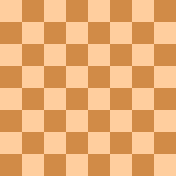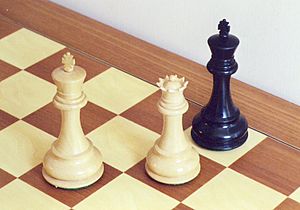Check and checkmate facts for kids
In the game of chess, a check happens when your king is directly attacked by an opponent's piece. When your king is in check, you must immediately do something to protect it. You cannot ignore the attack. There are three main ways to get your king out of check:
- Capture the piece that is attacking your king. You can use your king or another one of your pieces to do this.
- Block the attack. This means placing one of your pieces between your king and the attacking piece. This only works if the attacking piece is a long-range piece, like a rook, bishop, or queen.
- Move your king to a different square where it is safe and not under attack.
If you cannot do any of these things, then your king is not just in check, but it is in checkmate.
What is Checkmate?
| a | b | c | d | e | f | g | h | ||
| 8 |

|
8 | |||||||
| 7 | 7 | ||||||||
| 6 | 6 | ||||||||
| 5 | 5 | ||||||||
| 4 | 4 | ||||||||
| 3 | 3 | ||||||||
| 2 | 2 | ||||||||
| 1 | 1 | ||||||||
| a | b | c | d | e | f | g | h | ||
Checkmate (often called mate) is the main goal in chess. It happens when a player's king is attacked (in check) and there is absolutely no way to escape that attack. Simply put, your king is under attack and cannot move to safety, block the attack, or capture the attacking piece. The player whose king is checkmated loses the game.
History of Check and Checkmate
The rules for check and checkmate have been a part of chess since the game began. For a long time, it was common for players to say "Check!" out loud when they attacked the opponent's king. This was a way to warn the other player.
However, this tradition changed over time. By the early 20th century, saying "Check!" became less common. Today, in competitive chess games, players usually do not talk to each other unless it is absolutely necessary for the game.


